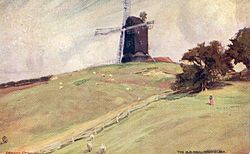St Leonard's Mill, Winchelsea facts for kids
Quick facts for kids Winchelsea Windmill |
|
|---|---|

The mill c1905
|
|
| Origin | |
| Mill name | St Leonard's Mill |
| Mill location | TQ 902 176 |
| Coordinates | 50°55′34″N 0°42′18″E / 50.926°N 0.705°E |
| Year built | 1760 (moved 1823) |
| Information | |
| Purpose | Corn mill |
| Type | Post mill |
| Roundhouse storeys | Single storey roundhouse |
| No. of sails | Four sails |
| Type of sails | Two Spring sails and two Common sails |
| Windshaft | Wood |
| Winding | Roof mounted fantail |
| Fantail blades | Eight blades |
| No. of pairs of millstones | Two pairs, Head and Tail |
| Year lost | 1987 |
St Leonard's Mill was a special type of windmill called a post mill. It stood in Winchelsea, a town in East Sussex, England. Sadly, this old mill was completely destroyed during the powerful Great Storm of 1987.
Contents
The Mill's Journey Through Time
Building and Moving the Mill
St Leonard's Mill was first built in 1760. It was originally located in a place called Iham. Old maps from 1808 and 1813 show it standing there. But by 1823, the mill was carefully moved to a new spot. This new location was on the old remains of St Leonard's church.
Life and Repairs at the Mill
Windmills need a lot of care. In 1861, a millwright named Benjamin King was working on the mill. He was fitting a new part called a "stock" when a serious accident happened. The mill kept working until the 1890s. By the 1920s, it was no longer used and started to fall apart.
Good news came in 1935 when the mill was repaired. They even added fake sails to make it look complete, but these didn't last long. The mill got another repair in 1955. In 1975, the National Trust, a group that protects historic places, became responsible for looking after the mill.
The Great Storm of 1987
In February 1978, a strong wind blew out the back of the mill. But the biggest challenge came on the morning of October 16, 1987. A huge storm, known as the Great Storm of 1987, hit England. The powerful winds were so strong that they blew St Leonard's Mill completely down.
After the storm, parts of the mill could still be seen on the ground. One of its large millstones was saved. This millstone was later used to help fix another old windmill called Lowfield Heath Windmill. Today, a special marker called Winchelsea's Millennium Beacon stands where the windmill once proudly stood.
How the Mill Worked
Understanding a Post Mill
St Leonard's Mill was a post mill. This means the entire top part of the mill, which held all the machinery, could turn around on a large central post. This allowed the mill to face the wind from any direction. It also had a single-storey roundhouse at its base.
Sails and Power
The mill had four large sails. Two of these were "Spring sails" and two were "Common sails." These sails were attached to a wooden "Windshaft." This wooden windshaft was special because it was one of the last in Sussex without a metal end.
Grinding Grain
To turn grain into flour, the mill used millstones. St Leonard's Mill had two main pairs of millstones, called "Head" and "Tail" stones. It also had a third pair of stones. These extra stones were powered by a belt from an "Upright Shaft." This shaft got its power from the mill's tail wheel.
Images for kids


